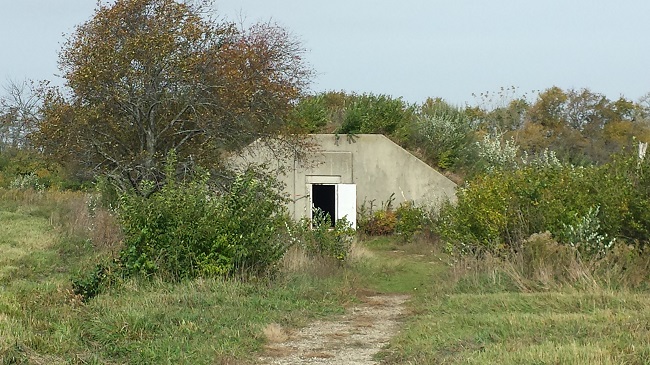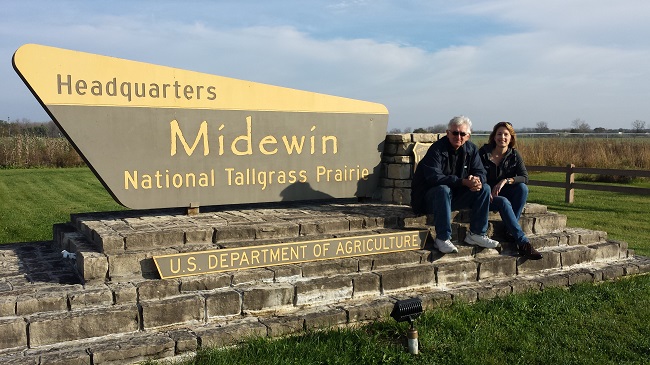Midewin: Where the Buffalo Roam
Podcast: Play in new window | Download (Duration: 1:24:44 — 38.9MB)
Subscribe: Apple Podcasts | Spotify | Android | iHeartRadio | Podchaser | Email | TuneIn | RSS | More
Mike and Peggy return to Midewin National Tallgrass Prairie
THE PODCAST FROM MIDEWIN CONTAINS SOME AUDIO BREAKUP NEAR THE BEGINNING, WHICH IS CORRECTED AS THE PROGRAM GOES ON. HEY, FOLKS, WE WERE IN THE MIDDLE OF A PRAIRIE! WE THINK YOU WILL ENJOY THE PROGRAM DESPITE THE MINOR TECHNICAL DIFFICULTIES.
(September 30, 2018) Has it really been been two years since Peggy and I were last at Midewin National Tallgrass Prairie near Wilmington, Illinois? That’s a rhetorical question, because I know that it really has been that long. By the way, Midewin is pronounced Mid-DAY-win, and the National Tallgrass Prairie is a unit within the USDA Forest Service.
Two years ago, we talked about bison on the show, and on my blog I noted that

On May 9, 2016, President Barack Obama signed the National Bison Legacy Act, which made the North American bison the official National Mammal of the United States. Given the history of this animal, and the concerted effort of the U.S. Government to wipe the species from the face of the earth in the late 19th Century, you could call this event ironic, or perhaps payback, or you could simply sit back and wonder at how much the world has changed in a little over a hundred years.
No matter how you look at it, the introduction of bison to Midewin in 2015, known as The Bison Project, is a remarkable accomplishment.
Part of the experiment is to determine if bison grazing will promote forb, grass and shrub diversity that is more compatible with native tallgrass prairie. The integration of bison into Midewin’s restoration practices will also look at if the bison provide a higher quality habitat for grassland birds and other animals, when compared to prairie habitat maintained by cattle grazing.
Another part of the experiment is to provide safe public education opportunities about bison, their life history and role in prairie ecosystems.
You can even follow the action on Bison Cam, which was installed a few weeks after we visited in fall of 2016. By the way, Midewin will celebrate National Bison Day from 10 a.m. to 2 p.m. on Saturday Nov. 3 near the Iron Bridge Trailhead.
One thing we didn’t do two years ago was a broadcast The Mike Nowak Show with Peggy Malecki from Midewin. Today, we’re here to correct that omission. And we’re going to cram a lot of stuff into two hours, so strap in.
 If everything goes well, we will be broadcasting either from in front of or on top of a bunker that used to be part of the Joliet Arsenal or Joliet Army Ammunition Plant, depending on exactly what years in and around World War II you’re talking about. At that time, hundreds of bunkers were built where TNT was stored, and many of them remain.
If everything goes well, we will be broadcasting either from in front of or on top of a bunker that used to be part of the Joliet Arsenal or Joliet Army Ammunition Plant, depending on exactly what years in and around World War II you’re talking about. At that time, hundreds of bunkers were built where TNT was stored, and many of them remain.
The Illinois Land Conservation Act of 1995 that created Midewin set aside almost 19,000 acres of seriously degraded land in an attempt to
reassemble the full array of species and natural processes typical of the tallgrass prairies, including the reintroduction of bison. Nothing remotely on this scale or complexity has ever been attempted before. Turning back the clock from a landscape dominated by rusting munitions factories and abandoned ammunition bunkers into a 20,283-acre pristine prairie will strain our collective intellect, willpower, and pocketbook.
I remember first seeing Midewin about a decade after it had been created. At that time, it was more about the past than the future. It’s amazing how much has been accomplished a little more than two decades into the mission.
We start today with Prairie Supervisor Wade Spang, with whom Peggy and I spoke in 2016. He’ll give us an overview and an update of work at the prairie. Our other guests will be
Patrick Williams, Manager of Communications for Openlands, which was a member of the coalition of 23 partners that lobbied to bring Midewin into existence in 1996.
Trevor Edmonson, Midewin Project Manager for The Wetlands Initiative (TWI). In 2016, the National Forest Foundation (NFF) and TWI launched a multi-year plan to restore land at Midewin in partnership with the U.S. Forest Service. This seven-year strategic effort, which is called Midewin’s New Spring, includes managing invasive vegetation, replanting native grasses and wildflowers, and removing infrastructure across 1,800 acres to link together a nearly contiguous 4,000-acre native landscape on Midewin’s west side.
Mike Redmer, Fish & Wildlife Biologist from US Fish & Wildlife Service. Midewin is partnering with U.S. Fish & Wildlife Service in Wilmington in the fight against Asian Carp in the Great Lakes
Lynn Kurczewski, Director of Visitor Services for the Forest Preserve District of Will County. This district is responsible for the development of the Wauponsee Glacial Trail, which are two former railroads that stretch 22.29 miles from Joliet south through Manhattan, Symerton and Florence and Wesley townships to Custer Park. Trail access is located within Midewin’s footprint.
Andrea Pletkze, Vice President of the Will County Trail Riders. We’re not 100% sure, but we think there will be a surprise for us somewhere around the beginning of the second hour.
Kelsay Shaw is from Possibility Place Nursery, just down the road in Monee, Illinois. They specialize in growing native trees and shrubs that are indigenous to northeast Illinois. Ninety percent of their seed is collected in Northern Indiana, Illinois, Wisconsin, and Iowa. Kelsay will speak to the importance of native woody plants (shrubs and trees) to local food webs and how to choose proper species for an urban yard that will benefit local and migrant species.
Allison Cisneros is the Midewin Project Manager for The Nature Conservancy in Illinois and Kathryn Gorman is Assistant Volunteer Coordinator for TNC. Midewin’s award-winning volunteer program engages hundreds of volunteers each year who support prairie restoration, plant/wildlife monitoring, environmental education, archaeology, and visitor services. Volunteers harvest hundreds of pounds of native seed, clean it, mix it, and do some hand broadcasting in wetland areas, which saves Midewin tens of thousands of dollars each year in native seed.
We think there will also be a few surprises and, of course meteorologist Rick DiMaio will provide us with his excellent weather and climate report. He will be on the phone, though I know he would enjoy the splendor of the Midewin tall grasses. Certainly Peggy and I will, and we hope you join us by listening live or catching up with the program via podcast or the Facebook live stream.

